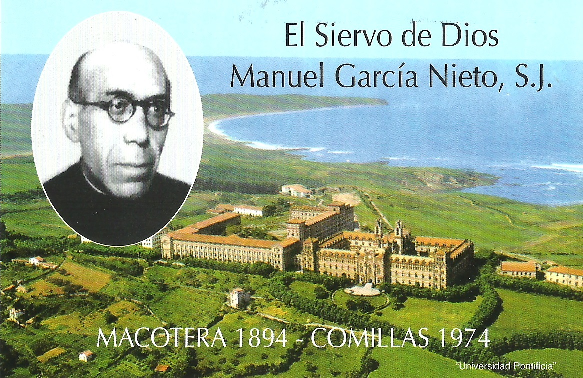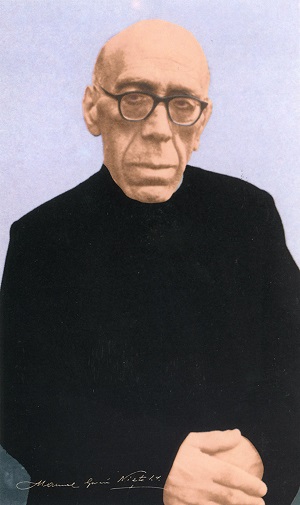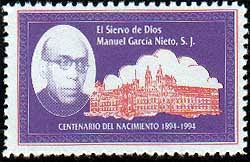April 13th - Servant of God Emmanuel Garcia Nieto, SJ
Born: April 5, 1894
Died: April 13,1974
 Emmanuel was born in the small town of Macotera in the Spanish province of Salamanca. He was the youngest of nine children and had his early education in the local public school. When he was fourteen he told his widowed mother that he would like to enter the diocesan seminary, where his brother Ramon was a student. His mother who was thinking of Emmanuel’s fragile health and also the fact that she would be left alone as five of her nine children had died in infancy, and of those surviving two daughters became nuns and the other son a seminarian, thought it was better for him to wait a bit longer. But his tears changed her fears and Emmanuel enrolled at the minor seminary in 1908 but was allowed to pursue his study of Latin under a tutor at home.
Emmanuel was born in the small town of Macotera in the Spanish province of Salamanca. He was the youngest of nine children and had his early education in the local public school. When he was fourteen he told his widowed mother that he would like to enter the diocesan seminary, where his brother Ramon was a student. His mother who was thinking of Emmanuel’s fragile health and also the fact that she would be left alone as five of her nine children had died in infancy, and of those surviving two daughters became nuns and the other son a seminarian, thought it was better for him to wait a bit longer. But his tears changed her fears and Emmanuel enrolled at the minor seminary in 1908 but was allowed to pursue his study of Latin under a tutor at home.
Emmanuel went to live at the Jesuit-directed diocesan seminary in Salamanca a year later where for the first time he came into contact with members of the Society. However he had to return home for his third year of Latin because of poor health and when he returned to the seminary a year later in Sep 1911, the Jesuits had left. He then spent the next nine years studying rhetoric, philosophy, and theology and was ordained on May 16, 1920 as a priest for the Salamanca archdiocese.
During his two years as assistant pastor and later pastor in two rural parishes, .Fr GarciaNieto kept his interest in Jesuit spirituality, read books on the Society and also attended retreats given by Jesuits. His final decision to enter the Society on July 26, 1926 came about after he spoke to Jesuit Fr Rafael Garrido and later went to the novitiate at Carrion de los Condes to make a retreat under his direction. Despite the sixteen years difference between him and the other novices, the thirty-two-year-old priest fitted in perfectly, working in the kitchen, cleaning corridors and teaching catechism to local children. After he took his vows, he was sent to the scholasticate in Ona to review his theology and a year later he was assigned as spiritual father of the youngest students at the Comillas seminary and college at Santander to be their confessor and their teacher on prayer, meditation and ascetical life. Life at the Comillas seminary ran smoothly until the coming of Spain’s Second Republic in 1931. When news of the burning of convents arrived at Comillas on May 11, 1931, Fr Garcia Nieto remarked: “What can the reds do us? Cut off our heads? They can keep mine, I’m going to heaven.” When the government dissolved the Society in Spain, confiscated its property and forbade the Jesuits to live in community, Fr Garcia Nieto continued to live at the Comillas seminary as it was a pontifical institution but they have to live in private houses offered them by various families in Comillas.
 Fr Garcia Nieto took over as the spiritual director of the entire seminary on January 29, 1932. On the morning of August 12, 1936 less than a month after the revolution broke out, two dozen buses and trucks came to the seminary and ordered the 200 students and staff inside to get ready to go to Santander. Fr Garcia Nieto encouraged the students: “We are in the best of hands. Jesus and Mary won’t let you down.” They were transported to Santander and detained in the Salesian college for 2 day and released. Fr Garcia Nieto stayed in Santander and found housing with a private family and went about the city in disguise to look for his seminarians, making sure they had places to stay. He secretly celebrated Mass in private homes and took Communion to many. When Generalissimo Franco liberated Bilbao in June and Comillas in August, he returned to the seminary once again as spiritual director. As the number of students gradually increased so did his labours and he was able to restrict his direction to 240 theologians when an assistant was brought in 1950 to assist him.
Fr Garcia Nieto took over as the spiritual director of the entire seminary on January 29, 1932. On the morning of August 12, 1936 less than a month after the revolution broke out, two dozen buses and trucks came to the seminary and ordered the 200 students and staff inside to get ready to go to Santander. Fr Garcia Nieto encouraged the students: “We are in the best of hands. Jesus and Mary won’t let you down.” They were transported to Santander and detained in the Salesian college for 2 day and released. Fr Garcia Nieto stayed in Santander and found housing with a private family and went about the city in disguise to look for his seminarians, making sure they had places to stay. He secretly celebrated Mass in private homes and took Communion to many. When Generalissimo Franco liberated Bilbao in June and Comillas in August, he returned to the seminary once again as spiritual director. As the number of students gradually increased so did his labours and he was able to restrict his direction to 240 theologians when an assistant was brought in 1950 to assist him.
With the changes in theological education and seminary life following Vatican Council II, Fr Garcia Nieto no longer felt adequate to continue in his role. He was seventy-three when he moved into the Jesuit residence in Comillas as its spiritual director and also did pastoral work, worked with the poor and gave retreats to seminarians, priests and religious until his eyesight and hearing failed. He however never gave up spiritual direction to many priests who flocked to see him. In 1973/1974, he developed severe bronchitis and heart trouble and had to be confined to the community’s infirmary. Fr Garcia Nieto’s health rapidly declined in early March 1974 and was anointed. He celebrated his last Mass on Holy Thursday morning and spent the whole of Good Friday before the tabernacle. When the infirmarian checked on him at 11.15 he saw the priest began to shake as if he were cold but the shaking did not stopped when he was covered with blankets. Although his breathing was getting heavier, Fr Garcia Nieto kept on praying: “Whatever you wish, Lord; if you wish today, then today; if tomorrow, then tomorrow; whatever you wish. Lord, forgive me my sins….I offer you my life, I offer you my death, my eternity. I offer these to you for the Church, the Society, for priests, and for the world.” On Holy Saturday, April 13 at 2 am, he surrendered his soul to his Maker.
 Fr Garcia Nieto spent his entire priestly life educating seminarians and fostering holiness in them. All who had come under him acknowledged his humility and holiness. The Archbishop of Oviedo, Gabino Diaz Merchan wrote of him: “ We have a saint in heaven and from there he will continue to assist Comillas, priests, Jesuits, the poor, and thus we hope – we who have received so much from him during his life. The death of a saint is an example for those who are still on pilgrimage. Will the Church canonize Fr Nieto, or not? We who have known him over so many years cannot think otherwise; he was a saint and his entire life has been an example for us.”
Fr Garcia Nieto spent his entire priestly life educating seminarians and fostering holiness in them. All who had come under him acknowledged his humility and holiness. The Archbishop of Oviedo, Gabino Diaz Merchan wrote of him: “ We have a saint in heaven and from there he will continue to assist Comillas, priests, Jesuits, the poor, and thus we hope – we who have received so much from him during his life. The death of a saint is an example for those who are still on pilgrimage. Will the Church canonize Fr Nieto, or not? We who have known him over so many years cannot think otherwise; he was a saint and his entire life has been an example for us.”
